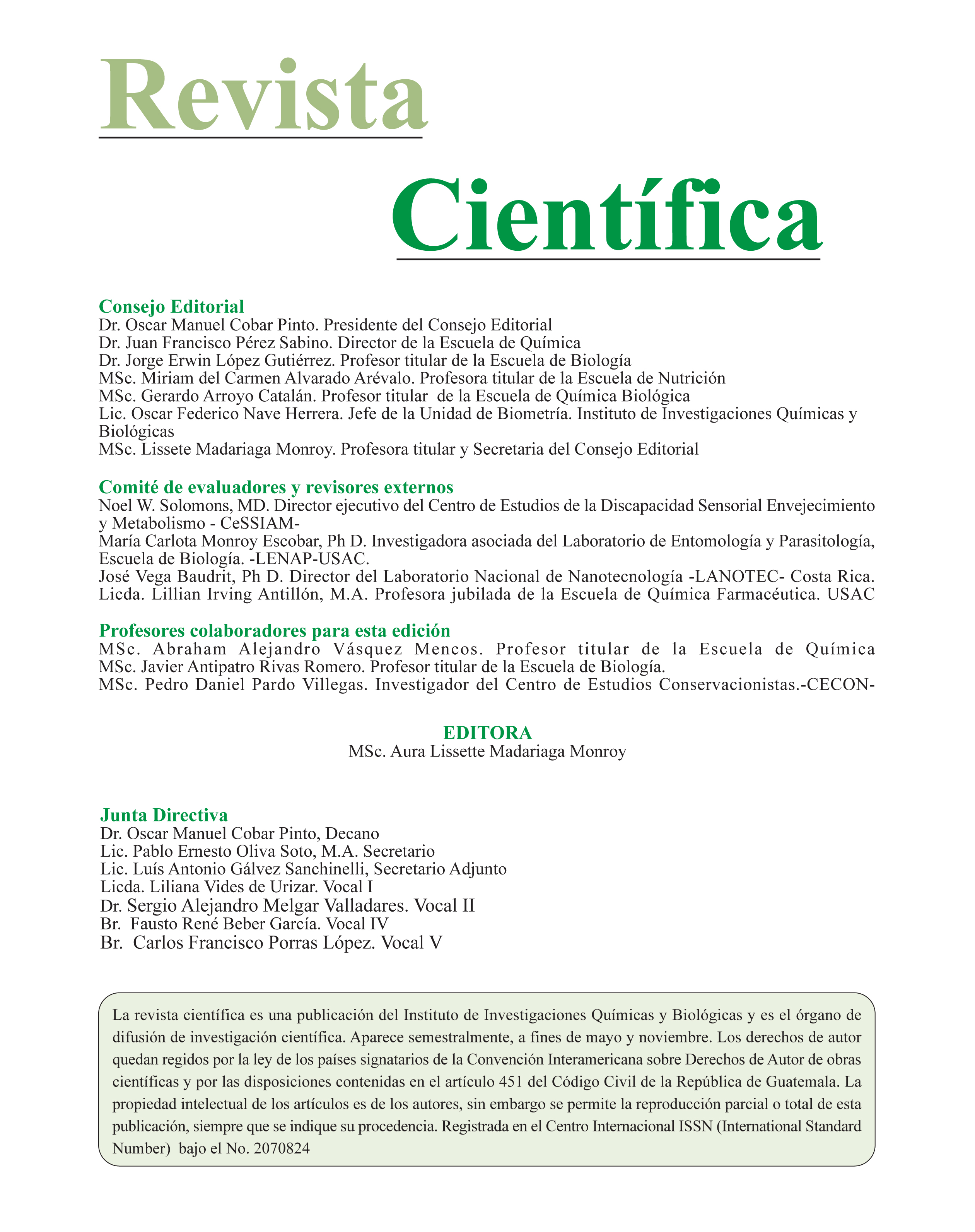Macronutrients, energy and minerals of "Panes Preparados": A descriptive study carried out in some food sales in the campus of the University of San Carlos of Guatemala.
DOI:
https://doi.org/10.54495/Rev.Cientifica.v22i1.124Keywords:
"Prepared bread", sausages, macronutrients, daily dietary recommendation, nutritional transitionAbstract
Guatemalan food culture has incorporated the international concept of hot dog, and has become a popular food with a variety of ingredients, as a "pan preparado". The major differences with the hot dog are: the bread is slightly coal roasted; additional mayonnaise, mustard and ketchup sauce, chopped cabbage and Guatemalan dressings as guacamol and chilli sauce are incorporated. The traditional sausage can be replaced by salami, chorizo, longaniza, bacon or roasted meat; either mixed, which includes all these meat products. A sample of a"pan preparado" was purchased in a "caseta" that were open between 11:00 and 13:00 am in the central campus of the University of San Carlos of Guatemala, stabilized in the laboratory and analyzed applying the Weende System for proximate analysis, during the following 15 days. The percentage composition of macronutrients of studied bread prepared with salami, chorizo, longaniza, sausage or bacon, are similar: 6-9% protein, 20-27% carbohydrates and 6-10% fat. Breads prepared with roasted meat and mixed meat products have higher percentage of protein (11-15%), less carbohydrates (13- 17%) and similar amount of fat (10%). Regarding the content of minerals, potassium and sodium were in the highest amount. A unit of studied bread weighing between 132 and 208 g, brings 317 to 417 kcal, and 806 to 1340mg of sodium. The high concentration of sodium is due to meat products, and covers 40-52%, 52% and 67% of the daily dietary recommendation –RDD- of sodium for adults, depending on whether is bread with one meat product, roasted meat or mixed meat products, respectively. Considering that excess of sodium in the diet is a risk factor for cardiovascular diseases, is recommended to limit the consumption of this kind of fast food.
Downloads
References
Barria P., Mauricio, R. y Amigo, H. (2006). Transición Nutricional: una revisión del perfil latinoamericano. Archivos Latinoamericanos de Nutrición, 56 (1), 03-11.
Greenfield, H y Southgate, D.A.T. (Ed). (2003). Datos de composición de alimentos. Obtención, gestión y utilización (2a ed.). Roma: Organización de las Naciones Unidas para la Agricultura y la Alimentación.
Hawkes, C. (2007). WHO Commission on Social Determinants of Health. Globalization, Food and Nutrition Transitions. Canada’s University. Institute of Population Health, Globalization and Health Equity. Recuperadode http://www.who.inst/social_determinants/resources/gkn_hawkes.pdf.
Jackson, M.C. (1970). Análisis Químico de Suelos (2a ed.) Barcelona, España: Omega.
Menchú, M.T. y Méndez, H. (Eds). (2007). Tabla de Composición de Alimentos de Centroamérica (2a ed.). Guatemala: INCAP.
Mendis, S. (2006). Pruebas científicas acerca de la función de la sal en la salud cardiovascular. En. Reunión Técnica de la OMS sobre la Reducción del Consumo de Sal. París, Organización Mundial de la Salud.
Organización de las Naciones Unidas para la Agricultura y la Alimentación. (2002). El Codex alimentarius y la venta ambulante. Recuperado de http://wwwfao.org/spanish/newsroom/action/facts_es_stret.htm
Popkin, B.M. (2004). La transición nutricional y el cambio mundial hacia la obesidad. Diabetes y Sociedad, 49 (3), 38-40
Salazar de Ariza, E. et al (2011). Composición nutricional de “pan con salchicha” disponible en el campus central, Universidad de San Carlos de Guatemala. Revista Científica. Instituto de Investigaciones Químicas y Biológicas, 20(1), 49-55 DOI: https://doi.org/10.54495/Rev.Cientifica.v20i1.144
Torún, B., Menchú, M.T. y Elías, L.G. (Ed). (1994). Recomendaciones Dietéticas Diarias del INCAP. Guatemala. Instituto de Nutrición de Centro América y Panamá. Organización Panamericana de la Salud.
Downloads
Published
How to Cite
Issue
Section
License
Copyright (c) 2012 J. Salazar de Ariza, A. Agueda, A. Utrilla, P. Del Aguila Mayén, P. Moreno, R. Guerra, Y. Argueta, M. Gómez, H. Quezada, G. Hernández, I. Batres, K. Rossal, Z. De León

This work is licensed under a Creative Commons Attribution 4.0 International License.
Authors who publish with this journal agree to the following terms:
- Authors retain copyright and grant the journal right of first publication with the work simultaneously licensed under a Creative Commons Attribution License 4.0 that allows others to share the work with an acknowledgement of the work's authorship and initial publication in this journal.
- Authors are able to enter into separate, additional contractual arrangements for the non-exclusive distribution of the journal's published version of the work (e.g., post it to an institutional repository or publish it in a book), with an acknowledgement of its initial publication in this journal.
- Authors are permitted and encouraged to post their work online (e.g., in institutional repositories or on their website) prior to and during the submission process, as it can lead to productive exchanges, as well as earlier and greater citation of published work.









